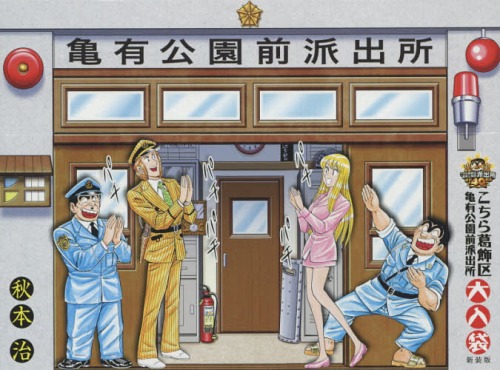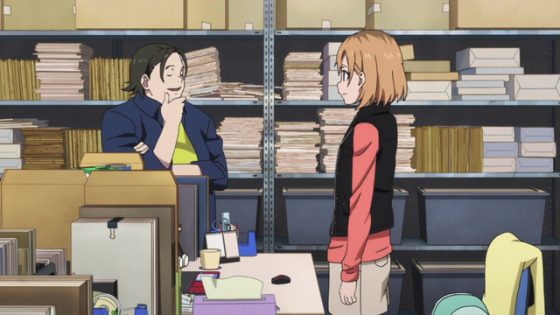
Fantasy adventures starring plucky teenagers setting out to save the world and slice-of-life high school stories waxing poetic about youth aren’t going anywhere. That being said, it certainly feels like anime has grown up a bit recently, doesn’t it? While you can’t say that we have to work through a deluge of office life anime like we do isekai or fantasy adventure series every year, there’s at least one show every season that covers the struggles of the working adult trying to make it in the corporate world.
So what gives? What made animation studios suddenly decide to start branching out? Let’s take a look.
A Quick, Early History Of Anime and the Workplace
Workplace anime is not actually that new. In fact, one of Shonen Jump’s premiere series, Kochira Katsushika-ku Kameari Koen-mae Hashutsujo (shortened to KochiKame) began all the way back in 1976. Despite being about policemen, KochiKame was more about how the officers got along at the station rather than about police work (think Brooklyn 99 for kids with even less detective work).
However, its goal was to make children—their target audience—laugh at the absurdities of adults. While KochiKame was not the first series to tap into mindset (the manga Warau Salesman, a collection of stories about office workers getting enticed by Faustian bargains, predates it by a good 8 years), it does overall reflect the anime market of the era that would continue all the way through the mid-2000s. It targeted a younger fanbase as a means to sell toys and merchandise to children. Even anime and manga like KochiKame and Warau Salesman dropped the adults altogether in order to implement themes more relatable to kids, which often meant stories about finding work as a media personality like Kodomo no Omocha or Kaleido Star. At its most adult, you might find series starring teachers tackling issues relevant to students of the day, like the smash success Great Teacher Onizuka.
Adult Fans’ Relationship with Anime
Because of the industry’s focus on children and high school students, anime and manga otaku had a massive stigma attached to them in Japan. After all, they were grown adults who enjoyed media for kids. It’s not unlike the stigma attached to Western comic and animation fans in America. However, since otaku were an extremely niche market and were following the series regardless of who they were actually meant for, there was really no need to change tactics.
That is, until the 2000s. The children’s market was rapidly shrinking due to lowering birth rates, an overcrowded market, and an economic collapse that was limiting how much people were willing to spend. Fewer and fewer people were running out to buy cheesy merchandise for their kids unless it was something immensely popular and in high demand. However, the people who were still spending money freely on anything they could were the lonely, adult otaku. Slice-of-Life high school series like Azumanga Daioh, Clannad, and K-On were proving immensely popular with this crowd due to their longing for those halcyon days before they were forced to join the working world.
This focus on youth is also precisely why studios did not feel the need to start growing up with their own audience. They could adapt manga about high schoolers under the guise of creating a kids show while making winks and nods to their adult fanbase. Even stories that weren’t slice-of-life like Eyeshield 21 and Kuroko no Basuke still found an older audience because adults would wistfully look back on their innocent club days when they had a real social group.
A-1 Studios
The earliest example of what we can call the modern workplace anime is A-1 Picture’s appropriately titled 2010 series Working!!. While the characters are still in high school, the story instead takes place outside of school and follows a group of kids working a part-time job together, getting to know each other due to their part-time jobs rather than club activities. Working!! still appealed to nostalgia-addled adults by focusing on high school students, but this also spoke to them on a level that other high school anime didn’t. This wasn’t just waxing poetic about times long gone; these working kids were relatable to the everyday struggles of the salarymen and office ladies of the present due to the setting.
Working!!’s success certainly didn’t go unnoticed by the company, as, in addition to greenlighting a sequel series to be released in 2012, they also acquired the license to the extremely popular seinen manga (series targeted to adult men) Uchuu Kyodai (or Space Brothers translated into English) to release the same year. This was a massive turn for both them and the industry, as Uchuu Kyodai was a very different series than what anime fans were used to. While it does have a shounen-esque plot about a man striving to achieve his childhood dream of becoming an astronaut, seinen anime were already an extreme niche in an already niche industry. Its hero was a recently-fired salaryman whose main source of conflict was putting up with the day-to-day bureaucracy of JAXA and NASA, along with some education for the audience on how astronauts train for space travel.
While Uchuu Kyodai would go on to be a massive success, A-1 Studios would also quietly work on another series that would go on to be a cult favorite. During this time, A-1 Studios also picked up the license for the 4-koma manga Servant x Service, a 2013 slice-of-life comedy about working in the Japanese bureaucracy at a small city hall office. Honestly, if the characters weren’t employed in the government, you wouldn’t even think twice about the fact that it came from the studio that did Working!!. However, by moving up the ages of the characters, A-1 Studios managed to sneak in an underlying subtext of trying to find meaning in doing menial government labor.
The Modern Workplace Anime
Uchuu Kyoudai and Servant x Service are perhaps the most emblematic for the direction of workplace anime for the future, focusing on the minutiae and struggle of everyday life while also trying to find meaning in one’s work. P.A. Works certainly noticed the popularity of these and found massive success covering many of the same themes in their hit 2014 series Shirobako, where they found a perfect balance of addressing workplace issues and appealing to the aging otaku market by directly making the office of Shirobako an animation studio.
However, the series that finally brought this discussion to the forefront was Sanrio’s surprisingly nihilistic 2016 mascot anime Aggretsuko, which brought the depressing subtext of Servant x Service right into the text. Here, Aggretsuko was outwardly miserable, but the childlike cuteness of Sanrio’s character design made the bleakness of its message easier to swallow.
Final Thoughts

Of course, other popular recent anime like Bookseller Honda and Wotakai have also taken a page from the lighter side of Servant x Service’s veneer, but this should cover the broader points of the subject.
Did we miss anything! Any other significant entries of workplace anime that we missed? Please let us know in the comments below!
Recommended Post
WWW.WORKING!! - Anime Fall 2016
Recommended Post
Netflix Announces Aggretsuko 2nd Season Coming 2019!
Recommended Post



